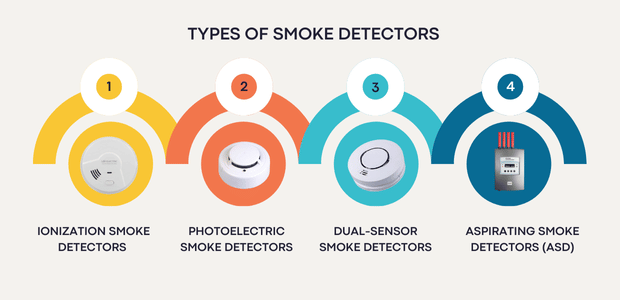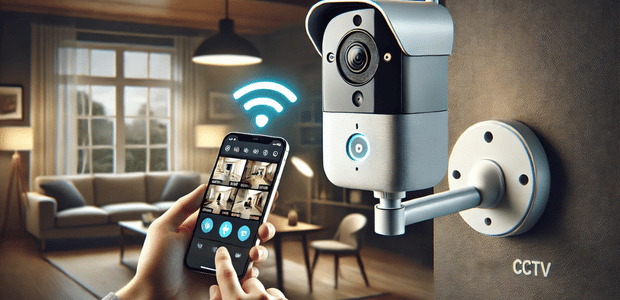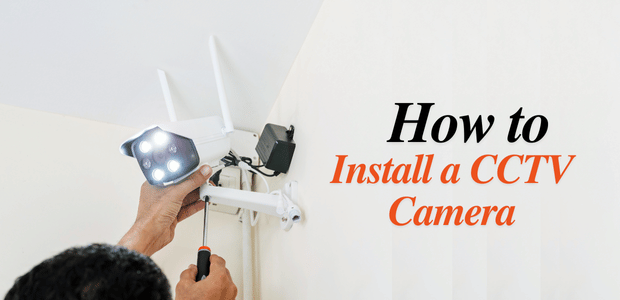Types of Smoke Detectors And How They Work

- March 16, 2025
- Interface Digital
Fire is one of the most destructive disasters a home or business can face. Within minutes, flames can spread, causing irreparable damage and risking lives. Smoke detectors serve as the first line of defense, providing early warnings that can mean the difference between life and death. Understanding the types of smoke detectors and how they work is crucial to choosing the right one for your space. In this guide, we’ll break down the different types of smoke detectors, how they work, and help you select the best one for your needs.
How Smoke Detectors Work
Smoke detectors are designed to identify smoke particles in the air and trigger an alarm before the fire spreads. Types of smoke alarms use different sensory technologies to detect smoke, and each type is optimized for specific fire scenarios. Both ionization sensors and photoelectric sensors play crucial roles in all types of smoke detectors. Some advanced detectors combine both technologies or use other methods, like air sampling or smart connectivity, to improve fire detection and safety.Main Types of Smoke Detectors
1. Ionization Smoke Detectors
An ionization smoke detector is an alarm that has two electrically loaded plates and a small quantity of radioactive material. When smoke hits these plates, it disturbs the flow of ions, setting off the alarm. These alarms are excellent for detecting smoke in houses. Especially, when a large volume of smoke gets created while cooking.How Ionization Technology Works
An ionization fire detector detects smoke particles in the air by ionizing them, which is helped by radioactive material. It is made up of an ionization chamber, two electrodes, and a tiny radioactive source.When smoke enters the chamber, it interrupts the ionization process, resulting in a drop in the electric current across the electrodes. This activates the detector's alarm mechanism, which may sound a loud siren, flash lights, or activate a fire alarm system.Best Use Cases
- It is ideal for detecting fires that spread quickly, like kitchen or electrical fires.
Pros and Cons
1) Pros- Fast response
- Affordable and widely available
- Availability
- Compatibility
- Easy installation and maintenance.
- False alarms
- Slow-smoldering fires
- Radioactive Material
- Limited Coverage Area
2. Photoelectric Smoke Detectors
A photoelectric smoke detector employs a light beam to detect any signs of smoke. According to the NFPA, these alarms are more effective at alerting when a fire starts from a smoldering source. It can be anything such as a burning cigarette that drops onto a couch cushion. Before a fire breaks out, smoldering flames can fill a home with harmful gasses.Photoelectric smoke detectors also come in different types like hardwired photoelectric smoke detectors or hard wired photoelectric smoke alarms.How Photoelectric Technology Works
A photoelectric smoke detector uses an LED light source to concentrate a beam of light onto a mirror, activating an alert when smoke enters the chamber. Photoelectric smoke alarms respond to smoldering fire smoke faster than ionization smoke alarms and can detect smoke before a fire starts.Best Use Cases
- It is effective for fires caused by cigarettes, overheated wires, or furniture igniting slowly.
Pros and Cons
1) Pros- Early Detection of Smouldering Fires
- Reduced False Alarms
- Enhanced Sensitivity
- Broader Applicability
- Limited Effectiveness for Fast-Flaming Fires
- Reliance on Smoke Particles
- Possibility for False Positives in Dusty Environments
- Slightly Higher Cost
3. Dual-Sensor Smoke Detectors
The National Fire Protection Association (NFPA) defines dual sensor smoke detectors as those that employ both ionization and photoelectric sensors to improve fire detection. Ionization sensors are sensitive to severe flames, but photoelectric sensors are more responsive to slow-burning fires. When combined into a single device, they provide a wider range of protection.Why They Provide Better Protection
Dual-sensing smoke alarms integrate two sensors, allowing faster and more precise fire detection. They reduce false alarms and increase true fire detection.Best Applications
- It is best for homes, apartments, and offices where various fire risks exist.
Pros and Cons
1) Pros- Comprehensive Fire Detection
- Reduced False Alarms
- Enhanced Safety and Peace of Mind
- Compliance with Safety Recommendations
- Cost-Effective Protection
- Higher Initial Cost
- Maintenance and Battery Replacement
- Potential for Over-Detection
- Installation Complexity
- Limited Availability in Some Markets
4. Aspirating Smoke Detectors (ASD)
An aspirating smoke detector is a central device equipped with sample chambers for detecting smoke particles in the air. It uses laser technology to monitor light-scattering particles and identify smoke particles at varied sensitivity levels. If a fire is detected, an alarm is triggered, and the system may be linked to fire control panels to assure building safety.How ASD Systems Function
- Uses a network of pipes to draw in air from different areas.
- Air is analyzed in a central chamber for microscopic smoke particles, triggering an alarm if smoke is detected.
Ideal For
- Large spaces like warehouses, data centers, and hospitals where early smoke detection is essential.
Pros and Cons
1) Pros- Early detection of fire
- Adaptable to different environments
- Integration with fire suppression systems
- It is expensive to purchase.
- It is not a DIY job, the installation process is complex. You may require a professional to install ASDs.
- Maintenance cost is too high.
5. Smart Smoke Detectors
Smart smoke detectors can send you alerts about smoke and potentially harmful CO levels via a smartphone app. They can detect and tell you when your batteries are going low. You may also disable alerts using the app rather than needing to press a button on the detector. They also offer WiFi connectivity and integration with smart home systems. Sadly, it is more expensive than standard smoke detectors.Key Features
- You receive real-time alerts on your smartphone.
- You also receive voice notifications and multi-room connectivity.
- It can integrate with home automation systems like Alexa or Google Home.
- It can also detect potentially harmful CO levels.
Advantages Over Traditional Smoke Detectors
- You receive instant alerts even when you’re away from home.
- Some models allow for remote silencing of false alarms.
- It can be connected to other smart safety devices for a fully automated system.
- For proper functioning, a steady internet connection is necessary.
Other types of smoke detectors
- Heat sensitive smoke alarms: A heat-sensitive smoke alarm, is frequently referred to as a heat detector. It detects large temperature changes rather than individual smoke particles.
- Duct type smoke detectors: They allow early detection of smoke and combustion products in air crossing through HVAC ducts.
Choosing the Right Smoke Detector
When selecting a smoke detector, you should consider these factors:- Home Size and Layout: Larger homes may need multiple interconnected detectors. In this case, smart detectors are the best choice.
- Fire Risks: If you live in an area with frequent electrical fires or flammable materials, dual-sensor detectors provide the best protection.
- Budget: Ionization and photoelectric models are affordable, while smart detectors and ASD systems are more expensive.
Recommended Placement for Maximum Protection
- Every floor of your house should have a smoke detector installed.
- Place detectors inside and outside bedrooms for better safety.
- Avoid installing detectors too close to kitchens to prevent false alarms.
Maintenance Tips to Ensure Functionality
- Test detectors monthly by pressing the test button.
- Replace batteries once a year or use 10-year sealed battery models.
- To prevent dust and debris from interfering with sensors, clean detectors on a regular basis.
- Change smoke detectors every 10 years for optimal performance.
Conclusion
Knowing the types of smoke detectors and how they work can help you choose the right smoke detectors. These detectors save lives and protect property. Whether you choose an ionization, photoelectric, dual-sensor, aspirating, or smart smoke detector, the important thing is ensuring proper installation and maintenance. Don't wait for an emergency—test your smoke detectors regularly and keep them in working condition. Fire safety starts with awareness and preparedness!Also read: How to Switch Off Smoke Detector








